Bitcoin dramatic late-October renaissance is more than folklore—it’s a phenomenon grounded in clear, recurring blockchain dynamics that fintech-savvy investors recognize as signals of deeper market strength. The market’s yearly “Uptober” surge continues to fascinate, but this cycle is decisively shaped by structural shifts visible in on-chain data.
Historically, a $100 position opened on October 1 has grown to approximately $120–$125 by month’s end since 2020, reflecting robust, repeatable growth. This uptick isn’t random luck; rather, it’s the consequence of supply mechanics evolving on-chain. Recent data confirms that by mid-month, Bitcoin’s exchange reserves typically contract by 0.5–1%, as coins shift away from trading platforms and into self-custody solutions. The outcome: reduced liquidity and heightened price sensitivity, with smaller buy orders able to catalyze outsized moves.

Source: cryptoquant
October’s early days are frequently dominated by short-term traders, whose activity tempers price action. As sentiment transitions, long-term holders begin accumulating once again, reigniting bullish conviction and setting the stage for a decisive rally. Simultaneously, stablecoin inflows swell, underscoring an influx of new capital ready to move into digital assets. The combined effect of these trends amplifies buying pressure and tilts the balance in favor of late-month breakouts.
This year, the macro backdrop is especially relevant. The Federal Reserve’s anticipated rate cut later this month, alongside pivotal U.S.–China diplomatic events, injects another layer of liquidity and optimism across risk assets—including crypto. Investors are now forced to reckon with both on-chain fundamentals and shifting policy as dual engines driving Bitcoin’s passage through October.
Ultimately, the “Uptober” phenomenon is less a mystery than a lesson in market structure and behavioral finance: savvy fintech investors who decode these signals not only anticipate Bitcoin’s moves, but capitalize on one of the most reliable seasonal cycles in crypto markets.
Disclaimer: This article is provided for informational purposes only and does not constitute financial advice. Investors should always conduct their own thorough research and consult with a qualified financial advisor before making any investment decisions in cryptocurrencies, which are highly volatile and speculative assets.
You might be interested in





